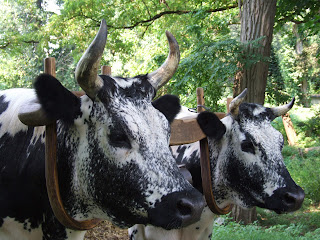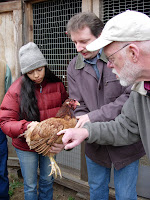In an effort to secure the term Heritage in the food and agricultural marketplaces, the American Livestock Breeds Conservancy (ALBC), a non-profit organization working to ensure the survival of rare breeds of livestock and poultry, has defined the term Heritage Cattle and established criteria for beef and dairy products made from Heritage Cattle breeds. In 2005 and 2009 respectively, ALBC defined the terms Heritage Turkey and Heritage Chicken which have become widely accepted in the marketplace.
“The goal of defining Heritage for cattle and their products is to secure a market niche for the term so that these historic breeds can be promoted in their own right,” said ALBC’s Executive Director Charles Bassett.
Cattle have been a part of the American agricultural landscape since the arrival of Spanish colonists beginning in 1493. During the colonization of America, cattle indigenous to Europe were brought over with the settlers. For centuries these breeds provided milk, meat, leather, tallow, draft power, and companionship.
Today, many cattle breeds that were once core components of regional cultures are in danger of extinction. Variety is decreasing as production is increasing. As cultures are homogenized and historic agricultural traditions are abandoned, the flavors and food traditions of these breeds, and the breeds themselves, are threatened. Through Heritage branding efforts, ALBC hopes to raise awareness of and support for endangered breeds of livestock. The ultimate goal is to ensure the long-term genetic conservation of these breeds.
Heritage Cattle, as defined by ALBC’s definition, must meet several criteria:
1. True Genetic Breed. The breed is a true genetic breed of cattle. That is, when mated together, it reproduces the breed type.
2. Endangered Breed. The breed is or has been endangered, as defined by the American Livestock Breeds Conservancy (ALBC), and appears on the ALBC Conservation Priority List in the Critical, Threatened, Watch, or Recovering categories. (CPL)
3. Long History in US. The breed has an established and continuously breeding population in the United States since 1925. If developed since 1925, foundation stock is no longer available. If more recently imported, the breed is globally endangered.
4. Purebred Status. Heritage Cattle must be registered purebred animals or immediate offspring of registered purebred animals. Cattle that are the result of a breed association sanctioned grade-up program must have obtained purebred status.
Once cattle have met the criteria above, their products too must be evaluated against the criteria established for Heritage Cattle products.
ALBC worked with a number of partners and organizations to develop these criteria, addressing elements such as diet, management practices, antibiotic and hormone usage, environment, and humane treatment. The crafters of the definition struggled with including the management criteria, but sound arguments for management’s influence on a breed’s genetics prevailed. “We are after a definition that catches the interaction of genome, management, and manufacturing that provides for a sustainable, closed system,” said ALBC Technical Advisor Dr. Phillip Sponenberg.
Belted Galloway breeder Karen Thornton illustrates the point. “Genetics are lost when management practices are homogenized,” said Thornton. “There were once thousands of farms with varying environments which allowed for gene expression and perpetuation of many characteristics not needed in intensively managed systems. Adaptation to varying management practices led to the development of breeds to suit many more purposes than we see today.”
So why does the American Livestock Breeds Conservancy, an organization interested in genetic diversity, care about defining Heritage Cattle? As late as the mid-1950s, cattle breeds such as the Pineywoods, Randall Lineback, and Red Poll were found on small farms across the country. In less than 50 years, nearly 60 percent of all beef cattle operations closed their doors, production strategies changed, and breeds of interest changed. Animals valued for their survival skills, reproductive health, and sound, functional bodies were replaced by animals with faster growth rates and larger sizes.
As a result, many breeds disappeared from the American dinner table. “We need to give these animals their jobs back,” said Marjorie Bender, research and technical programs director for ALBC. “These hardy, tasty, historic and culturally significant breeds need to find a market niche again. If we can help them find their place at the table, we are much more likely to save their valuable, versatile genes.”
“Genetic diversity is the key to change,” added Bender. “Diversity brings options and choices. Agriculture has changed dramatically in the past 60 years and it will continue to change. If our generation stewards the animals well, we – ourselves, our children, and future generations - will have options.”
Heritage breeds provide necessary genetics for a healthy, diverse food system. These genetics help to secure our food system. “To rely on only a few breeds is, well, to put all our eggs in one basket,” said Bender.
While the definition of Heritage Cattle may be complex, the goal is to ensure that the legacy left to succeeding generations has as much genetic breadth and biological robustness as the current generation has inherited from previous generations. The definition draws attention to endangered breeds of cattle, supports their genetic integrity and long-term conservation, encourages management strategies that are biologically appropriate and agriculturally sustainable and celebrates the cultural and culinary traditions of these breeds.
To see the complete definition of Heritage Cattle and their products visit:
http://www.heritagecattle.org/
***











































 After dropping off hatching eggs, our first stop was the home of Rabbit Lockwood and Debbie Chard which is North of Charleston, in Huger, SC. Rabbit owns Marsh Tacky horses and is a harbor pilot in Charleston harbor. At 70 years-young, he knows a lot of history about the Lowcountry. We drove many miles through the swamp and through the Francis Marion National Forest, before we arrived at the inconspicuous gate for the home. Driving up the driveway, we could see open fields and huge, century-old live oak trees cloaked in Spanish moss. Up on the hill was the house of Longwood Plantation. It was beautiful.
After dropping off hatching eggs, our first stop was the home of Rabbit Lockwood and Debbie Chard which is North of Charleston, in Huger, SC. Rabbit owns Marsh Tacky horses and is a harbor pilot in Charleston harbor. At 70 years-young, he knows a lot of history about the Lowcountry. We drove many miles through the swamp and through the Francis Marion National Forest, before we arrived at the inconspicuous gate for the home. Driving up the driveway, we could see open fields and huge, century-old live oak trees cloaked in Spanish moss. Up on the hill was the house of Longwood Plantation. It was beautiful.


 After dinner and documenting local history and animals, we turned in for the night. Next stop, Charleston….
After dinner and documenting local history and animals, we turned in for the night. Next stop, Charleston….




